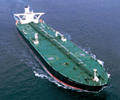North Sea floating storage high amid slack Asian demand

Rising light sweet crude production in Libya and west Africa, combined with slack demand for North Sea grades in China, has caused a build-up of crude in floating storage in the Atlantic basin and even prompted one very large crude carrier (VLCC) to pause its eastward journey and anchor off the coast of Mauritania.
Upwards of 9mn bl of North Sea crude is currently being stored aboard stationary tankers, more than 7mn bl of which is Forties crude.
The 2mn bl Sea Lynx is floating offshore Southwold, UK, and is now signalling for Rotterdam, having completed a ship-to-ship transfer with the Forties-laden 1mn bl Advantage Sun this morning.
The Sea Lynx has been floating in the North Sea for several weeks. The tanker initially received two Forties cargoes from the similarly-sized Desimi back in April — the Desimi having loaded its cargo at the Hound Point terminal, Scotland, on 9 March for Vitol. But Shell subsequently offered cargoes loading from the ship at Scapa Flow, Scotland, with Vitol securing one loading on 29-31 May that was eventually offloaded to the 600,000 bl Thornbury at Scapa Flow. The Sea Lynx then returned to anchor offshore Southwold, partially laden with Forties crude, before topping up with more Forties from the Advantage Sun yesterday.
The Desimi — having transferred part of its Forties cargo to the Sea Lynx in mid-April — topped up with Forties crude at Hound Point towards the end of April, and has floated just outside the terminal since. Two 600,000 bl tankers — the Hildegaard and British Kestrel — have since loaded with Forties crude and joined the larger tanker, anchoring offshore Dunbar, Scotland. Vitol has offered crude cargoes loading on a ship-to-ship basis — usually a sign of an oversupplied market — from the British Kestrel, while Glencore has done so from the Hildegaard, both without success.
The 2mn bl Saiq — chartered by Shell to sail with Forties crude for China — has paused its journey after passing the Canary Islands. The Saiq loaded its Forties cargo at Hound Point for Shell on 24 May, before pausing briefly at Southwold, and then signalling for Tianjin, China and beginning its eastward voyage.
But last week Shell offered cargoes loading from the ship at Scapa Flow — without success — since which the tanker has anchored off the coast of Mauritania. The vessel then changed its signalled destination to Rizhao, China, but remains unmoved. Whether the tanker will continue its voyage or return to the Atlantic basin is uncertain, but it appears to be in no rush to reach Chinese shores, where independent refiners — often buyers of North Sea grades — are struggling with elevated stocks.
So far in June, just one VLCC has sailed east from Hound Point, the 2mn bl Atlantas — fixed by Total — which departed for South Korea. Five tankers sailed for Asia-Pacific in May.
Several fixtures have been made by Shell and Total in recent weeks, with a number failing, but almost all have been made for South Korea or “east”, not China specifically. The 2mn bl Gener8 Neptune is the most recent, fixed by Shell to depart Hound Point for Korea on 26 June.
Adding to the build-up of Forties crude, two 600,000 bl tankers — the United Grace and Alfa Britannia — which loaded with Ekofisk crude towards the end of last month remain anchored just outside of the Teesport crude terminal. Glencore has offered Ekofisk loading from the former at Scapa Flow, without success.
And the 1mn bl Thomas Zafiras has remained anchored offshore Southwold since departing the Norwegian Mongstad terminal — where Troll and Heidrun crudes are loaded — in mid-May.
Source: Argus
HEADLINES
- Do shipping markets want Biden or Trump for the win?
- All 18 crew safe after fire on Japanese-owned tanker off Singapore
- Singapore launching $44m co-investment initiative for maritime tech start-ups
- Cosco debuts Global Shipping Industry Chain Cooperation Initiative
- US warns of more shipping sanctions
- China continues seaport consolidation as Dalian offer goes unconditional